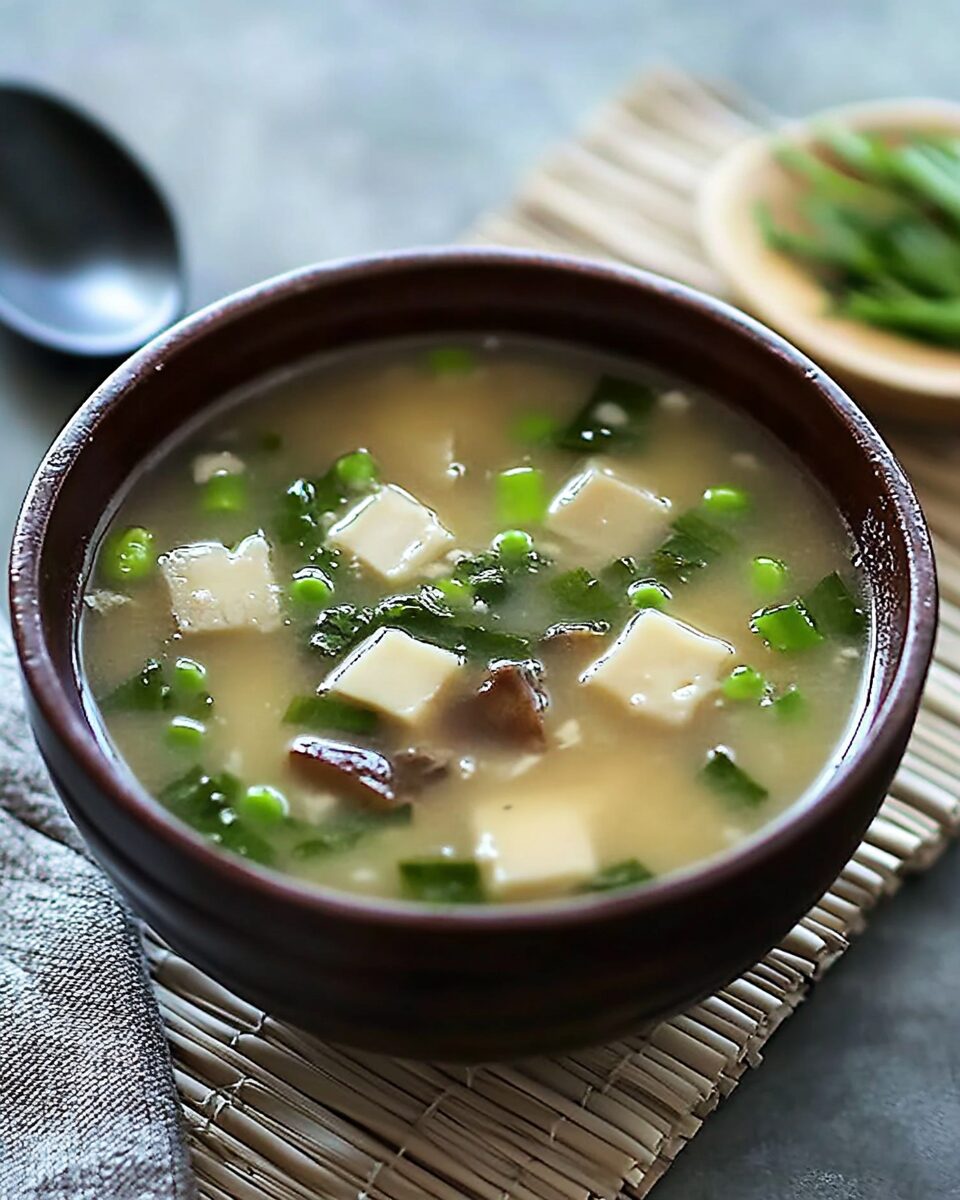Miso soup is a traditional Japanese dish made from dashi stock and miso paste, often enhanced with tofu, seaweed, and green onions. It’s a simple yet flavorful dish that’s commonly served as a starter in Japanese cuisine.
Full Recipe:
Ingredients
- 4 cups water
- 1 (4-inch) piece kombu (dried kelp)
- 1/2 cup bonito flakes
- 3 tablespoons white miso paste
- 1/2 cup diced tofu
- 2 tablespoons chopped green onions
- 1 tablespoon dried wakame seaweed
Directions
- In a pot, heat 4 cups of water over medium heat. Add the kombu and let it simmer for 5 minutes. Remove the kombu before boiling.
- Add bonito flakes to the pot and simmer for another 2 minutes. Strain the broth, discarding the bonito flakes.
- Return the broth to the pot over low heat. Dissolve the miso paste by stirring it into the broth gently. Do not boil.
- Add tofu, wakame seaweed, and green onions. Let them warm for 2-3 minutes.
- Serve hot and enjoy!
Nutritional Facts (per serving)
- Calories: 50
- Protein: 4g
- Carbohydrates: 5g
- Fat: 2g
- Sodium: 800mg
- Fiber: 1g
The History of Miso Soup
Miso soup has deep roots in Japanese history, dating back to the Heian period (794-1185) when Buddhist monks introduced miso paste as a nutritious food source. Initially a delicacy reserved for the aristocracy and samurai warriors, miso gradually became a staple in the diets of all social classes.
During the Kamakura period (1185-1333), the practice of making dashi broth, a fundamental component of miso soup, became widespread. This development significantly enhanced the dish’s flavor and made it more accessible. Over time, miso soup evolved to incorporate local ingredients, leading to regional variations that remain popular today.
The Role of Miso in Japanese Culture
Miso soup is more than just a dish; it’s an integral part of Japanese daily life. Many households begin their day with a bowl of warm miso soup, as it is believed to aid digestion and provide lasting energy. In traditional Japanese meals, miso soup is often served alongside rice, pickles, and a main dish, creating a well-balanced meal. Miso soup is also a symbol of hospitality and comfort in Japan. It is commonly served in home-cooked meals and at restaurants, ranging from casual eateries to high-end kaiseki establishments. Many Japanese people associate the taste of miso soup with childhood memories and family traditions.
Types of Miso Used in Miso Soup
The flavor of miso soup largely depends on the type of miso paste used. Miso paste is made from fermented soybeans, rice, or barley, and its flavor can range from mild and sweet to strong and salty. Some of the most common types of miso include:
- Shiro Miso (White Miso): A mild and slightly sweet miso with a shorter fermentation time, commonly used in light, delicate soups.
- Aka Miso (Red Miso): A darker, richer miso with a stronger umami flavor, often used in heartier miso soups.
- Awase Miso (Mixed Miso): A blend of white and red miso, offering a balanced flavor suitable for various dishes.
- Mugi Miso (Barley Miso): A type of miso made from barley, with a slightly nutty and earthy taste.
The Importance of Dashi Broth
Dashi broth is the foundation of miso soup, providing depth and umami flavor. Traditional Japanese miso soup is typically made with one of the following dashi variations:
- Kombu Dashi: A vegetarian-friendly broth made by simmering kombu (dried kelp) in water, offering a mild yet flavorful base.
- Katsuobushi Dashi: Made by steeping bonito flakes (dried fish shavings) in hot water, resulting in a smoky, umami-rich broth.
- Niboshi Dashi: A broth made from dried sardines, providing a more intense and slightly briny taste.
- Shiitake Dashi: A plant-based alternative made by soaking dried shiitake mushrooms, adding a deep and earthy flavor.
Common Ingredients and Variations
While the essential components of miso soup include miso paste, dashi broth, and tofu, there are numerous regional and seasonal variations. Some common ingredients added to miso soup include:
- Wakame Seaweed: A nutrient-rich seaweed that softens when added to the soup.
- Tofu: Silken or firm tofu is often included for protein and texture.
- Green Onions: Chopped scallions provide a fresh, slightly pungent flavor.
- Mushrooms: Shiitake, enoki, or maitake mushrooms enhance the umami depth.
- Daikon Radish: Sliced daikon adds a mild sweetness and slight crunch.
- Eggplant, Potatoes, or Carrots: Root vegetables make the soup heartier.
Different regions of Japan have their own take on miso soup. In Nagano Prefecture, miso soup is often made with barley miso, while in Kyoto, a lighter white miso is preferred. In the Tohoku region, miso soup may include salmon or seafood due to the colder climate.
Health Benefits of Miso Soup
Miso soup is packed with nutrients and is considered a superfood due to its various health benefits:
- Rich in Probiotics: Miso is a fermented food, meaning it contains live beneficial bacteria that support gut health and digestion.
- High in Antioxidants: Miso contains vitamins and minerals, including vitamin K, manganese, and zinc, which help strengthen the immune system.
- Supports Heart Health: Some studies suggest that regular consumption of miso soup may help lower blood pressure and reduce the risk of heart disease.
- Boosts Energy Levels: The combination of miso, dashi, and tofu provides a good balance of protein, essential amino acids, and energy-boosting nutrients.
- Aids in Detoxification: The seaweed in miso soup is known for its detoxifying properties, helping to eliminate heavy metals from the body.
How Miso Soup Fits Into a Balanced Diet
Miso soup is a versatile dish that can be incorporated into various meal plans. It is low in calories yet filling, making it a great addition to both weight loss and muscle-building diets. The protein from tofu and the fiber from seaweed and vegetables contribute to satiety, reducing overall calorie intake.
For those following a vegetarian or vegan diet, kombu or shiitake dashi can be used as a base instead of fish-based dashi. Additionally, gluten-free versions of miso are available for those with dietary restrictions.
The Global Popularity of Miso Soup
Although miso soup originated in Japan, its popularity has spread worldwide. Many Japanese restaurants across the globe serve miso soup as a staple dish. In recent years, miso has also become a key ingredient in fusion cuisine, appearing in salad dressings, marinades, and even pasta sauces.
As more people recognize the benefits of fermented foods, miso soup continues to gain traction in health-conscious communities. The rise of plant-based diets has also increased demand for miso-based recipes, making miso soup a favorite among vegetarians and vegans.
Conclusion
Authentic miso soup is more than just a simple broth—it is a dish that reflects the essence of Japanese cuisine. With its deep historical roots, diverse regional variations, and numerous health benefits, miso soup has earned its place as a beloved staple in Japanese households and beyond.






